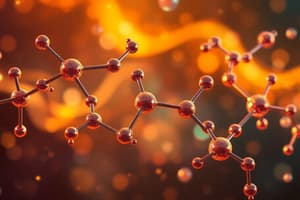Podcast
Questions and Answers
What is the key difference between the C=O bond in aldehydes/ketones and the C=C bond in alkenes?
What is the key difference between the C=O bond in aldehydes/ketones and the C=C bond in alkenes?
- The C=O bond is less planar
- The C=O bond is more polar (correct)
- The C=O bond is longer
- The C=O bond is less reactive
What is the common suffix used to name aldehydes?
What is the common suffix used to name aldehydes?
- -al (correct)
- -oic acid
- -ol
- -one
What is the common suffix used to name ketones?
What is the common suffix used to name ketones?
- -oic acid
- -one (correct)
- -al
- -ol
Which of the following is a method for synthesizing ketones?
Which of the following is a method for synthesizing ketones?
Which functional group can be used as a substituent with the suffix -yl?
Which functional group can be used as a substituent with the suffix -yl?
What is the purpose of Tollens' reagent?
What is the purpose of Tollens' reagent?
What is the catalyst used to hydrate terminal alkynes to form ketones?
What is the catalyst used to hydrate terminal alkynes to form ketones?
What is the functional group present in aldehydes and ketones?
What is the functional group present in aldehydes and ketones?
What is the difference between the C=O bond and the C=C bond in alkenes?
What is the difference between the C=O bond and the C=C bond in alkenes?
What are the two categories of carbonyl compounds?
What are the two categories of carbonyl compounds?
How are aldehydes named?
How are aldehydes named?
How are ketones synthesized?
How are ketones synthesized?
What is Tollens' reagent used for?
What is Tollens' reagent used for?
What are the strong nucleophiles that can be used to reduce aldehydes and ketones?
What are the strong nucleophiles that can be used to reduce aldehydes and ketones?
Flashcards are hidden until you start studying
Study Notes
Aldehydes and Ketones: Nomenclature, Synthesis, and Reactions
- Aldehydes and ketones are characterized by the carbonyl functional group (C=O).
- Carbonyl compounds are abundant in nature and have many important applications in industry, biology, and pharmaceuticals.
- The C=O bond is planar, shorter, stronger, and more polar than the C=C bond in alkenes. Carbon is electrophilic and oxygen is nucleophilic.
- Carbonyl compounds can be categorized into two groups: aldehydes and ketones (R-C=O is bonded to H or C) and carboxylic acids and their derivatives.
- Aldehydes are named by selecting the longest carbon chain containing the -CHO group and replacing the terminal -e of the corresponding alkane with -al.
- Ketones are named by selecting the longest carbon chain containing the -C=O group and replacing the terminal -e of the corresponding alkane with -one.
- Aldehydes and ketones can also be named using common names.
- The R-C=O group can be used as a substituent, with the suffix -yl, and the prefix oxo- is used if other functional groups are present.
- Aldehydes can be synthesized by oxidizing primary alcohols using pyridinium chlorochromate (PCC).
- Ketones can be synthesized by oxidizing secondary alcohols using PCC, CRO3, or Na2Cr2O7 or by hydrating terminal alkynes in the presence of Hg+2 as a catalyst.
- Aromatic ketones can be synthesized through Friedel-Crafts acylation of an aromatic ring.
- Aldehydes can be oxidized to carboxylic acids using Tollens' reagent, which involves the use of silver ions in aqueous ammonia. Ketones are unreactive towards this reaction. Aldehydes and ketones can also be reduced using strong nucleophiles such as NaBH4 and LiAlH4.
Studying That Suits You
Use AI to generate personalized quizzes and flashcards to suit your learning preferences.





